10 Things We Learned From WWE Survivor Series 2003
The one where Vince McMahon defeated The Undertaker...
The year 2003 wasn't exactly WWE's finest for a variety of reasons. Fan interest dropped off, as there were no stars the calibre of Steve Austin or The Rock anchoring the weekly shows. Monday Night Raw was much less fun than it had been just a few years earlier when WWE was must-see TV on a weekly basis. And while some pay-per-views that year were pretty good (WrestleMania, Vengeance, Royal Rumble), others were truly and historically dreadful (Armageddon, Unforgiven, Judgment Day).
Survivor Series 2003 falls somewhere in between, saved mostly by a phenomenal elimination match pitting five babyfaces handpicked by Steve Austin, against five Eric Bischoff cronies, with the balance of power to be decided in the match (a nice 20th birthday present for this author). Shawn Michaels bled buckets during a dramatic final sequence, and it really saved the show from plunging deeper into mediocrity.
But the reliance on too many overexposed characters like the McMahons, Undertaker, Kane, Triple H (wait, is this Crown Jewel or Survivor Series?) sapped some of the flavour from what turned out to be a painfully average show. Stars of tomorrow like John Cena, Randy Orton and Batista shone brightly in their respective spots, so there was that, at least.
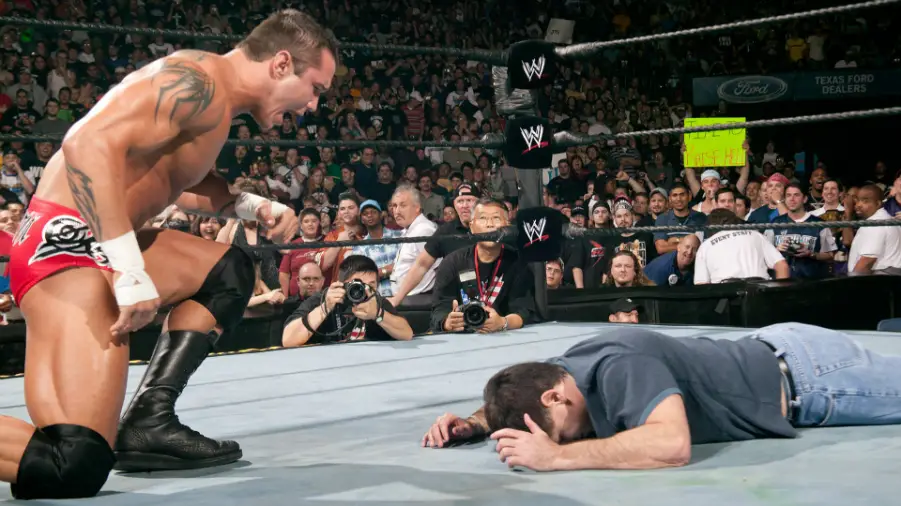 WWE
WWE
On the Sunday Night Heat pre-show, Cruiserweight Champion Tajiri defeated everyone's favourite "Redneck Messiah", Jamie Noble, to retain the belt. The match lasted only four minutes, but was decent enough, playing off of a recent angle in which Tajiri blinded Noble's girlfriend Nidia with optic nerve-killing black mist, which might be the same substance that Burger King used to colour the buns on their Halloween Whoppers.
Originally, the match was supposed to take place on the main card, but ended up being moved. Taking its spot on the PPV was an angle where Dallas Mavericks owner Mark Cuban (Survivor Series was in Dallas) knocked down Eric Bischoff, only to be planted with an RKO by an attacking Randy Orton. Say this much, Cuban did a helluva job selling the move.
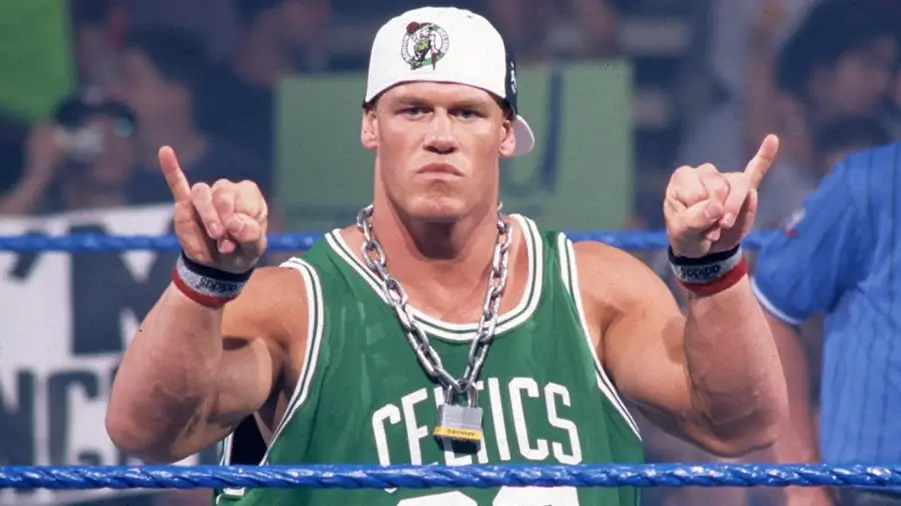 WWE
WWE
Survivor Series 2003 was notable for being John Cena's first pay-per-view appearance after his recent face turn, which would position him for his forthcoming run as a go-to star. Cena was drafted onto Kurt Angle's Survivor Series team, and on the go-home SmackDown, Cena teamed with fellow Survivor Series partner Chris Benoit to defeat Brock Lesnar and Big Show.
What *wasn't* seen by the home audience was a post-match angle in which Cena attacked Benoit, done as a way to maintain a Stone Cold-like "trust no one" edge. Veteran agent Michael Hayes pitched the idea for that very reason, and McMahon went with it, only to watch the in-house crowd express confusion and distaste with it. The angle ended up not airing on SmackDown, edited off to prevent confusing the home audience as well.
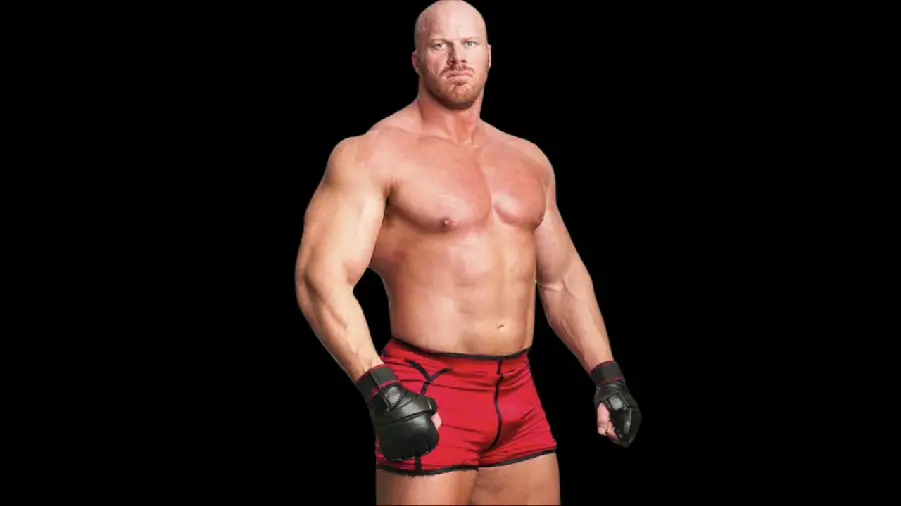 WWE
WWE
Brock Lesnar's Survivor Series team consisted of one colossus after another, as Big Show, Albert, Matt Morgan, and Nathan Jones backed him up in his quest to destroy Angle's quintet. Just eight months earlier, the hulking and frightening Jones was to have worked WrestleMania XIX, teaming with The Undertaker to battle Survivor Series teammates Show and Albert, but was pulled last minute due to his stark inexperience.
Jones' appearance in the Survivor Series match would mark his only WWE pay-per-view bout, nearly a year after some extremely-slick vignettes were aired, portraying Jones as a dangerous and disturbed ex-con that no one man could stop. Weeks after Survivor Series, while WWE toured the western Pacific part of the world, Jones quit the company upon returning to his native Australia. Shame, because Jones had the look of a star (even if he didn't have too much else).
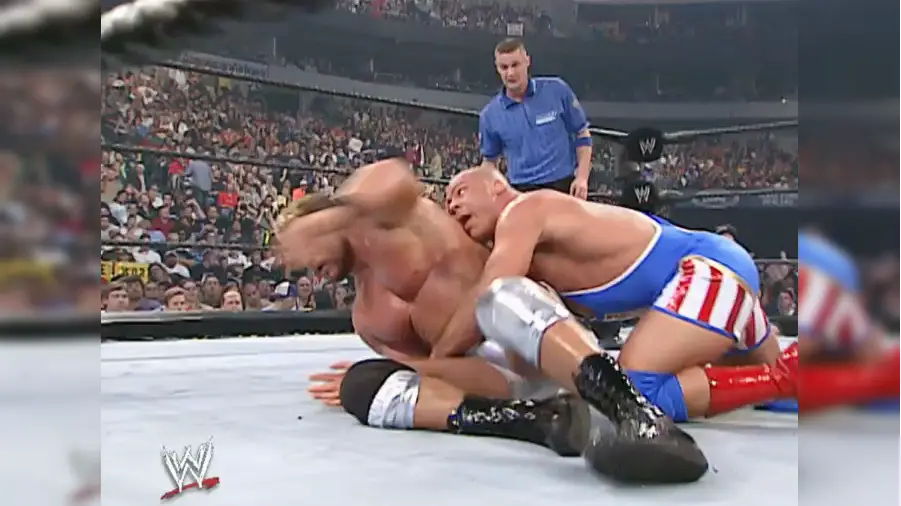 WWE
WWE
Looking back, it's staggering how many major events Kurt Angle worked through with troubling and concerning injuries. WrestleMania XIX is the most famous example, but it wasn't just that. SummerSlam 2003 saw Angle working through a torn hamstring, and Survivor Series the same year was another case of Angle being hampered by difficult pains.
Angle's injury this time was bone chips in his neck, and it was reported that the Olympic gold medalist was trying to take it as easy as possible around this time. Angle would actually miss about two months of in-ring action following the pay-per-view, only returning to action shortly before the 2004 Royal Rumble. Until then, Angle appeared here and there as a guest referee for the odd house show match.
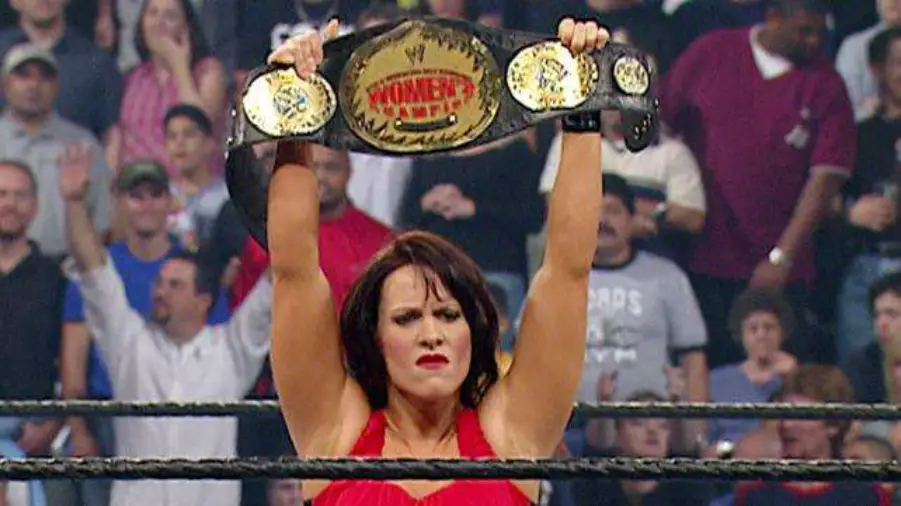 WWE
WWE
The Women's title match pitting champion Molly Holly against challenger Lita wasn't a whole lot to write home about, just a basic undercard match to establish the belt's continued existence, really. The most notable part of the match was actually Molly's left wrist, something that the commentators didn't call any attention to.
Molly wore a black wristband with the letters 'CH' on it. This was in tribute to Crash Holly, who died 10 days before the pay-per-view of a suicidal drug overdose. Crash's death wasn't acknowledged at all on WWE TV (despite him wrestling for the company as recently as five months earlier), though he did receive a 10 bell salute at a SmackDown live event in New York. Molly would later donate a portion of the profits from her 2005 shoot interview to an education fund for Crash's daughter.
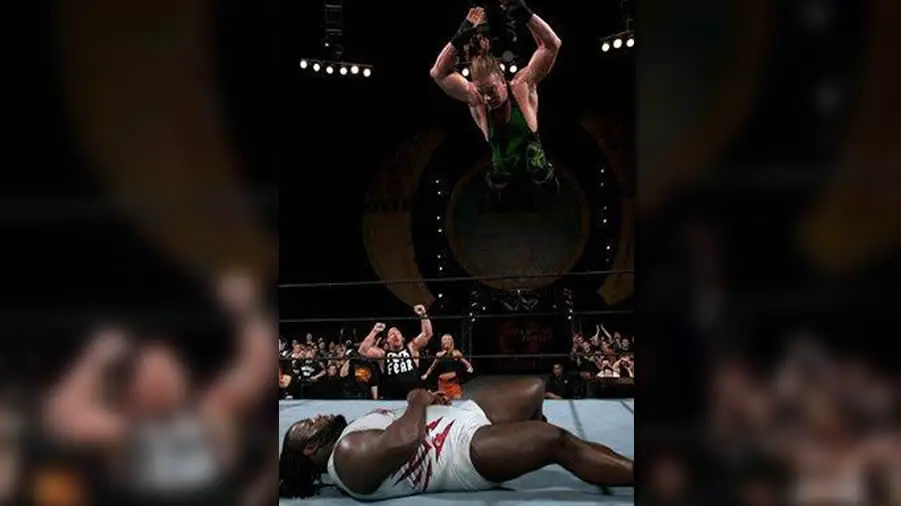 WWE
WWE
Today, he's a WWE Hall of Famer, having carved out a very prolific run in the latter half of his two-decade run with WWE. But earlier on, Mark Henry was struggling to gain traction and get out of the blocks. By the time Henry appeared on Eric Bischoff's Survivor Series team, to be quite frank, it was actually a surprise that WWE hadn't released him due to general ineffectiveness.
Henry's work in that Survivor Series match marked his first pay-per-view match in nearly four years. His last prior effort in a PPV encounter came against Viscera in a brief match at No Way Out 2000. Henry spent time in between either injured or trying to improve his work OVW. Coming through numerous injuries and stop/start runs on the roster, Henry would eventually make good on what WWE initially saw in him, but in 2003, many viewed him as a lost cause.
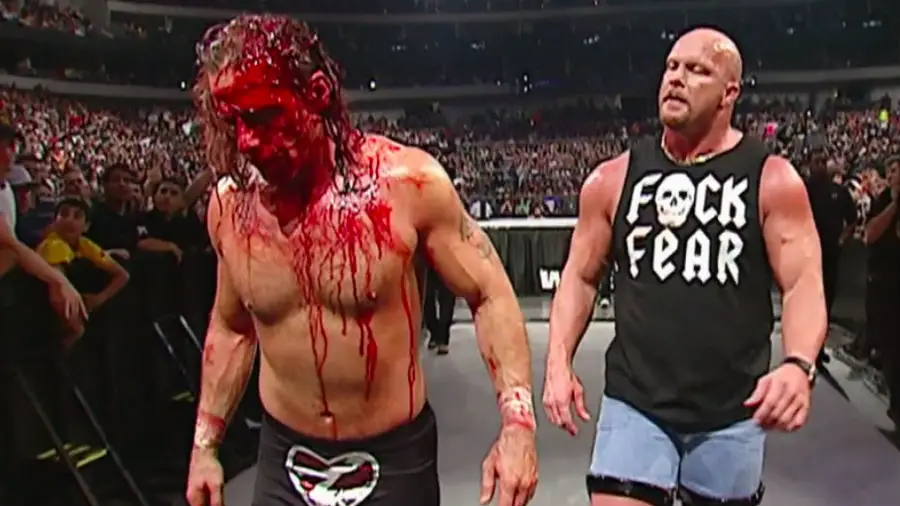 WWE
WWE
Look, it's professional wrestling - nobody goes away forever. Retirement and termination stipulations mean about as much as vows at a Kardashian wedding, and the departed return quickly enough, whether it's eight years later for Crown Jewel money, or almost instantly so that "the hero" can harass The Nexus until he gets job back. Steve Austin was forced out of WWE due to his team losing the big eliminator, and how long did "for good" mean here?
About six weeks, actually. Austin was fired from his co-GM position, only to return at the year-end Raw as the brand's official "Sheriff." It was a hackneyed role, because Austin could dish out punishment but take none in return, and Austin without odds to overcome is far less fun. At least we got a six-week respite from the cliche.
 WWE
WWE
Vince McMahon has had numerous impressive achievements in his life, but his most impressive might be surviving the excessive blood loss from his Buried Alive match against The Undertaker. Vinnie Mac spilled enough crimson to satisfy the Red Cross' annual quota, and still managed to win the match after Kane appeared, costing his brother the match (and, functionally, his biker gimmick).
The victory marked the last time McMahon would win a one-on-one pay-per-view match, having vanquished "The Dead Man" at the age of 58. Since then, Vince's only PPV victories have come in handicap matches at consecutive Backlash events, defeating Shawn Michaels in 2006 (it wasn't a tag team match because God no-showed), and Bobby Lashley the following year. In neither of those cases did Vince go all Eddie Guerrero at Judgment Day, mind you.
 WWE
WWE
The Triple H/Goldberg World Heavyweight title main event wasn't anything special, just your typical WWE style brawl with admittedly-average action. The most memorable part of the match was easily Triple H's outfit, as he eschewed his standard tights in favour of these garish bicycle shorts that concealed most of his thighs. They really gave Shawn Michaels' crap-brown tights from the year before a run for their money.
But they weren't there for fashion - they were either concealing a hefty tape job, or actively acting as a brace on their own, as Triple H was still mending from a torn groin. Uncharacteristically, Triple H was sporting a gut and a diminished musculature, understandably from an inability to really work out while injured. To put it mildly, Triple H had looked (and would look) healthier.
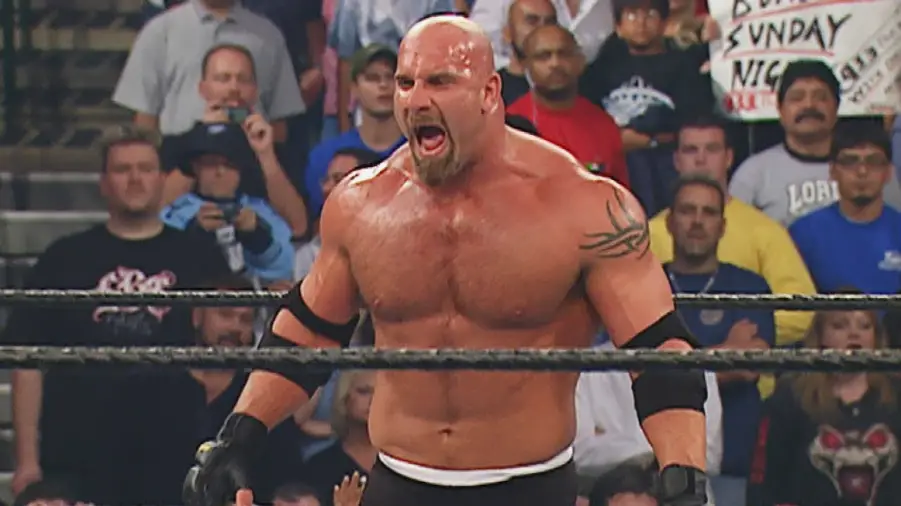 WWE
WWE
Was it the fact that Austin's job was on the line? Did fans want to see Goldberg defend a championship like it was 1998 all over again? Whatever the biggest draw of the 2003 Survivor Series was, it got the attention of the masses, as the event tied the 2001 show with the second highest buyrate in Survivor Series history, pulling in 450,000 buys, shockingly coming within 110,000 buys of tying a poorly-bought WrestleMania XIX.
The event essentially marked the end of a high point for Survivor Series, as although the 2005 show did 400,000 buys, every other Survivor Series since would do an alarmingly smaller number. It was even up 32 per cent from the 340,000 buys of the previous year's show, so there was some serious interest in the card.
Survivor Series 2003 falls somewhere in between, saved mostly by a phenomenal elimination match pitting five babyfaces handpicked by Steve Austin, against five Eric Bischoff cronies, with the balance of power to be decided in the match (a nice 20th birthday present for this author). Shawn Michaels bled buckets during a dramatic final sequence, and it really saved the show from plunging deeper into mediocrity.
But the reliance on too many overexposed characters like the McMahons, Undertaker, Kane, Triple H (wait, is this Crown Jewel or Survivor Series?) sapped some of the flavour from what turned out to be a painfully average show. Stars of tomorrow like John Cena, Randy Orton and Batista shone brightly in their respective spots, so there was that, at least.
10. Small Shift
 WWE
WWEOn the Sunday Night Heat pre-show, Cruiserweight Champion Tajiri defeated everyone's favourite "Redneck Messiah", Jamie Noble, to retain the belt. The match lasted only four minutes, but was decent enough, playing off of a recent angle in which Tajiri blinded Noble's girlfriend Nidia with optic nerve-killing black mist, which might be the same substance that Burger King used to colour the buns on their Halloween Whoppers.
Originally, the match was supposed to take place on the main card, but ended up being moved. Taking its spot on the PPV was an angle where Dallas Mavericks owner Mark Cuban (Survivor Series was in Dallas) knocked down Eric Bischoff, only to be planted with an RKO by an attacking Randy Orton. Say this much, Cuban did a helluva job selling the move.
9. You Can't See It
 WWE
WWESurvivor Series 2003 was notable for being John Cena's first pay-per-view appearance after his recent face turn, which would position him for his forthcoming run as a go-to star. Cena was drafted onto Kurt Angle's Survivor Series team, and on the go-home SmackDown, Cena teamed with fellow Survivor Series partner Chris Benoit to defeat Brock Lesnar and Big Show.
What *wasn't* seen by the home audience was a post-match angle in which Cena attacked Benoit, done as a way to maintain a Stone Cold-like "trust no one" edge. Veteran agent Michael Hayes pitched the idea for that very reason, and McMahon went with it, only to watch the in-house crowd express confusion and distaste with it. The angle ended up not airing on SmackDown, edited off to prevent confusing the home audience as well.
8. Blunder Down Under
 WWE
WWEBrock Lesnar's Survivor Series team consisted of one colossus after another, as Big Show, Albert, Matt Morgan, and Nathan Jones backed him up in his quest to destroy Angle's quintet. Just eight months earlier, the hulking and frightening Jones was to have worked WrestleMania XIX, teaming with The Undertaker to battle Survivor Series teammates Show and Albert, but was pulled last minute due to his stark inexperience.
Jones' appearance in the Survivor Series match would mark his only WWE pay-per-view bout, nearly a year after some extremely-slick vignettes were aired, portraying Jones as a dangerous and disturbed ex-con that no one man could stop. Weeks after Survivor Series, while WWE toured the western Pacific part of the world, Jones quit the company upon returning to his native Australia. Shame, because Jones had the look of a star (even if he didn't have too much else).
7. Pushing Through Pain
 WWE
WWELooking back, it's staggering how many major events Kurt Angle worked through with troubling and concerning injuries. WrestleMania XIX is the most famous example, but it wasn't just that. SummerSlam 2003 saw Angle working through a torn hamstring, and Survivor Series the same year was another case of Angle being hampered by difficult pains.
Angle's injury this time was bone chips in his neck, and it was reported that the Olympic gold medalist was trying to take it as easy as possible around this time. Angle would actually miss about two months of in-ring action following the pay-per-view, only returning to action shortly before the 2004 Royal Rumble. Until then, Angle appeared here and there as a guest referee for the odd house show match.
6. Subtle Acknowledgement
 WWE
WWEThe Women's title match pitting champion Molly Holly against challenger Lita wasn't a whole lot to write home about, just a basic undercard match to establish the belt's continued existence, really. The most notable part of the match was actually Molly's left wrist, something that the commentators didn't call any attention to.
Molly wore a black wristband with the letters 'CH' on it. This was in tribute to Crash Holly, who died 10 days before the pay-per-view of a suicidal drug overdose. Crash's death wasn't acknowledged at all on WWE TV (despite him wrestling for the company as recently as five months earlier), though he did receive a 10 bell salute at a SmackDown live event in New York. Molly would later donate a portion of the profits from her 2005 shoot interview to an education fund for Crash's daughter.
5. Stop And Start
 WWE
WWEToday, he's a WWE Hall of Famer, having carved out a very prolific run in the latter half of his two-decade run with WWE. But earlier on, Mark Henry was struggling to gain traction and get out of the blocks. By the time Henry appeared on Eric Bischoff's Survivor Series team, to be quite frank, it was actually a surprise that WWE hadn't released him due to general ineffectiveness.
Henry's work in that Survivor Series match marked his first pay-per-view match in nearly four years. His last prior effort in a PPV encounter came against Viscera in a brief match at No Way Out 2000. Henry spent time in between either injured or trying to improve his work OVW. Coming through numerous injuries and stop/start runs on the roster, Henry would eventually make good on what WWE initially saw in him, but in 2003, many viewed him as a lost cause.
4. Gone Forever?
 WWE
WWELook, it's professional wrestling - nobody goes away forever. Retirement and termination stipulations mean about as much as vows at a Kardashian wedding, and the departed return quickly enough, whether it's eight years later for Crown Jewel money, or almost instantly so that "the hero" can harass The Nexus until he gets job back. Steve Austin was forced out of WWE due to his team losing the big eliminator, and how long did "for good" mean here?
About six weeks, actually. Austin was fired from his co-GM position, only to return at the year-end Raw as the brand's official "Sheriff." It was a hackneyed role, because Austin could dish out punishment but take none in return, and Austin without odds to overcome is far less fun. At least we got a six-week respite from the cliche.
3. Victorious Vinnie
 WWE
WWEVince McMahon has had numerous impressive achievements in his life, but his most impressive might be surviving the excessive blood loss from his Buried Alive match against The Undertaker. Vinnie Mac spilled enough crimson to satisfy the Red Cross' annual quota, and still managed to win the match after Kane appeared, costing his brother the match (and, functionally, his biker gimmick).
The victory marked the last time McMahon would win a one-on-one pay-per-view match, having vanquished "The Dead Man" at the age of 58. Since then, Vince's only PPV victories have come in handicap matches at consecutive Backlash events, defeating Shawn Michaels in 2006 (it wasn't a tag team match because God no-showed), and Bobby Lashley the following year. In neither of those cases did Vince go all Eddie Guerrero at Judgment Day, mind you.
2. Practical Attire
 WWE
WWEThe Triple H/Goldberg World Heavyweight title main event wasn't anything special, just your typical WWE style brawl with admittedly-average action. The most memorable part of the match was easily Triple H's outfit, as he eschewed his standard tights in favour of these garish bicycle shorts that concealed most of his thighs. They really gave Shawn Michaels' crap-brown tights from the year before a run for their money.
But they weren't there for fashion - they were either concealing a hefty tape job, or actively acting as a brace on their own, as Triple H was still mending from a torn groin. Uncharacteristically, Triple H was sporting a gut and a diminished musculature, understandably from an inability to really work out while injured. To put it mildly, Triple H had looked (and would look) healthier.
1. One To Watch
 WWE
WWEWas it the fact that Austin's job was on the line? Did fans want to see Goldberg defend a championship like it was 1998 all over again? Whatever the biggest draw of the 2003 Survivor Series was, it got the attention of the masses, as the event tied the 2001 show with the second highest buyrate in Survivor Series history, pulling in 450,000 buys, shockingly coming within 110,000 buys of tying a poorly-bought WrestleMania XIX.
The event essentially marked the end of a high point for Survivor Series, as although the 2005 show did 400,000 buys, every other Survivor Series since would do an alarmingly smaller number. It was even up 32 per cent from the 340,000 buys of the previous year's show, so there was some serious interest in the card.
